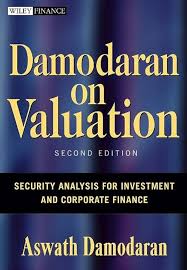Overview : Damodaran on Valuation
- Book Title: Damodaran on Valuation
- Author: Aswath Damodaran
- Publication Date: September 2016
- price: $9.33
- Pages: 696
Overview of the Book
"Damodaran on Valuation" is authored by Aswath Damodaran, a renowned professor of finance at New York University’s Stern School of Business. Widely considered the "Dean of Valuation," he is known for his expertise in corporate finance and equity valuation, and his work has been extensively used by academics and practitioners alike.
Introduction
In the ever-evolving world of finance and investing, mastering the art of valuation is crucial for making informed decisions. Damodaran on Valuation: Security Analysis for Investment and Corporate Finance" by Aswath Damodaran stands as a beacon of knowledge in this complex field. This comprehensive review explores why this book has become an indispensable resource for finance professionals, students, and anyone interested in understanding the true value of assets in today's dynamic markets.
Book Summary
Damodaran's work is a tour de force that bridges the gap between theoretical concepts and practical application in valuation. The book meticulously covers a wide range of valuation techniques, from fundamental discounted cash flow (DCF) models to more advanced approaches like real options and contingent claim valuation.
"The value of a business is determined by its cash flows, the uncertainty associated with those cash flows, and the expected growth in these cash flows." - Aswath Damodaran
This quote encapsulates the core philosophy that Damodaran expounds throughout the book, emphasizing the importance of cash flows in determining value.
Analysis of Themes
Comprehensive Coverage
The book's strength lies in its exhaustive coverage of valuation methodologies. Damodaran leaves no stone unturned, providing in-depth explanations of:
- Discounted Cash Flow (DCF) analysis
- Relative valuation techniques
- Option pricing models
- Valuation in distressed and start-up scenarios
Each topic is treated with rigor, ensuring readers gain a solid theoretical foundation while also learning how to apply these concepts in real-world situations.
Contextual Approach
One of the book's standout features is Damodaran's emphasis on context. He expertly illustrates how various factors such as market conditions, industry dynamics, and company-specific characteristics influence valuation outcomes. This contextual approach is particularly valuable in today's rapidly changing financial landscape, where factors like technological disruption and shifting market trends can significantly impact asset values.
Practical Application
"Damodaran on Valuation" excels in bridging theory and practice. The book is replete with case studies and examples that demonstrate how valuation principles are applied in real-life scenarios. Damodaran's inclusion of spreadsheets and online resources further enhances the book's practical utility, allowing readers to experiment with valuation models and adapt them to their specific needs.
Writing Style
Despite the complexity of the subject matter, Damodaran's writing is remarkably accessible. He has a talent for explaining intricate concepts in clear, concise language, making the book engaging for both novices and experienced professionals. The logical flow of information, coupled with well-placed diagrams and charts, ensures that readers can easily follow even the most complex valuation techniques.
Strengths and Weaknesses
Strengths:
- Comprehensive coverage of valuation techniques
- Strong balance between theory and practical application
- Clear, accessible writing style
- Incorporation of real-world examples and case studies
- Critical analysis of established valuation practices
Weaknesses:
- The depth of content may be overwhelming for absolute beginners
- Some examples may become dated as market conditions evolve
Comparison to Other Works
When compared to other valuation texts like "Investment Valuation" by the same author or "Valuation: Measuring and Managing the Value of Companies" by McKinsey & Company, "Damodaran on Valuation" stands out for its balance of depth and accessibility. While McKinsey's book may offer more corporate finance perspectives, Damodaran's work provides a more comprehensive view of valuation across various asset classes and scenarios.
Relevance to Current Market Trends
In today's financial landscape, characterized by volatile markets, emerging technologies, and changing investor behaviors, Damodaran's insights are more relevant than ever. The book's principles can be applied to valuing traditional assets as well as newer investment vehicles like cryptocurrencies and fintech startups. Damodaran's emphasis on adjusting valuation models to account for uncertainty is particularly valuable in navigating the current economic climate.
Highlights from Damodaran on Valuation
- Valuation fundamentals: Explains key valuation concepts and methodologies.
- Discounted Cash Flow (DCF): Focuses on DCF as a primary valuation tool.
- Risk and return: Emphasizes understanding risk to determine appropriate discount rates.
- Market comparables: Discusses how to use market multiples for valuation.
- Valuation in practice: Provides real-world applications across various industries.
- Adjustments for risk: Details how to adjust valuation models for company-specific risks.
- Corporate finance: Links valuation techniques to corporate strategy and decision-making.
Conclusion
"Damodaran on Valuation" is an essential read for anyone serious about finance, investing, or corporate strategy. Its comprehensive coverage, practical approach, and accessible style make it a valuable resource for both students and seasoned professionals. As financial markets continue to evolve, the principles and techniques outlined in this book will remain fundamental to the practice of valuation. For those looking to deepen their understanding of valuation or refine their financial analysis skills, this book is an invaluable investment. You can purchase "Damodaran on Valuation" on Amazon or find it at your local bookstore. By mastering the concepts in this book, readers will be better equipped to make informed investment decisions, analyze market trends, and navigate the complexities of personal finance in an ever-changing economic landscape.





